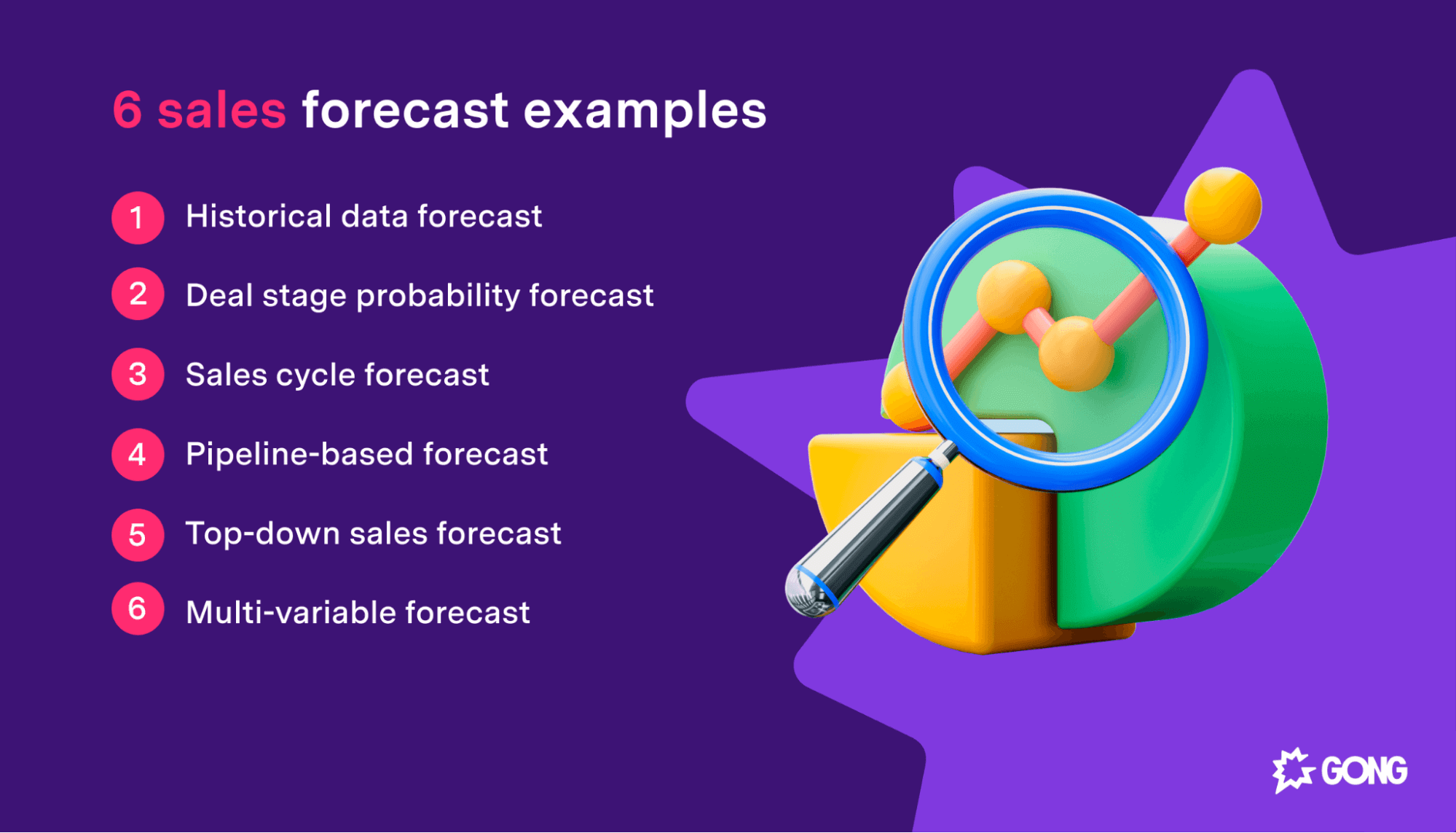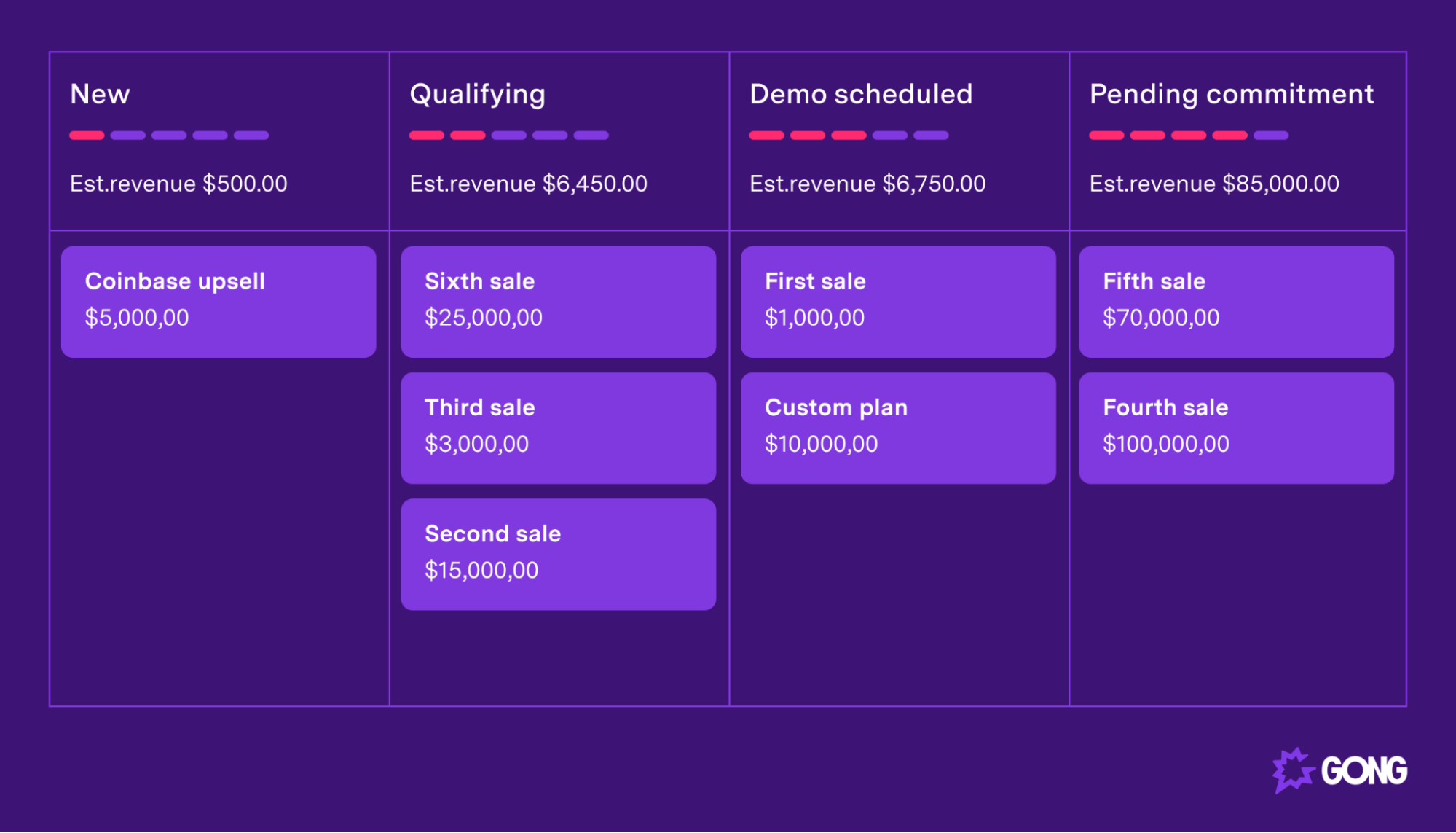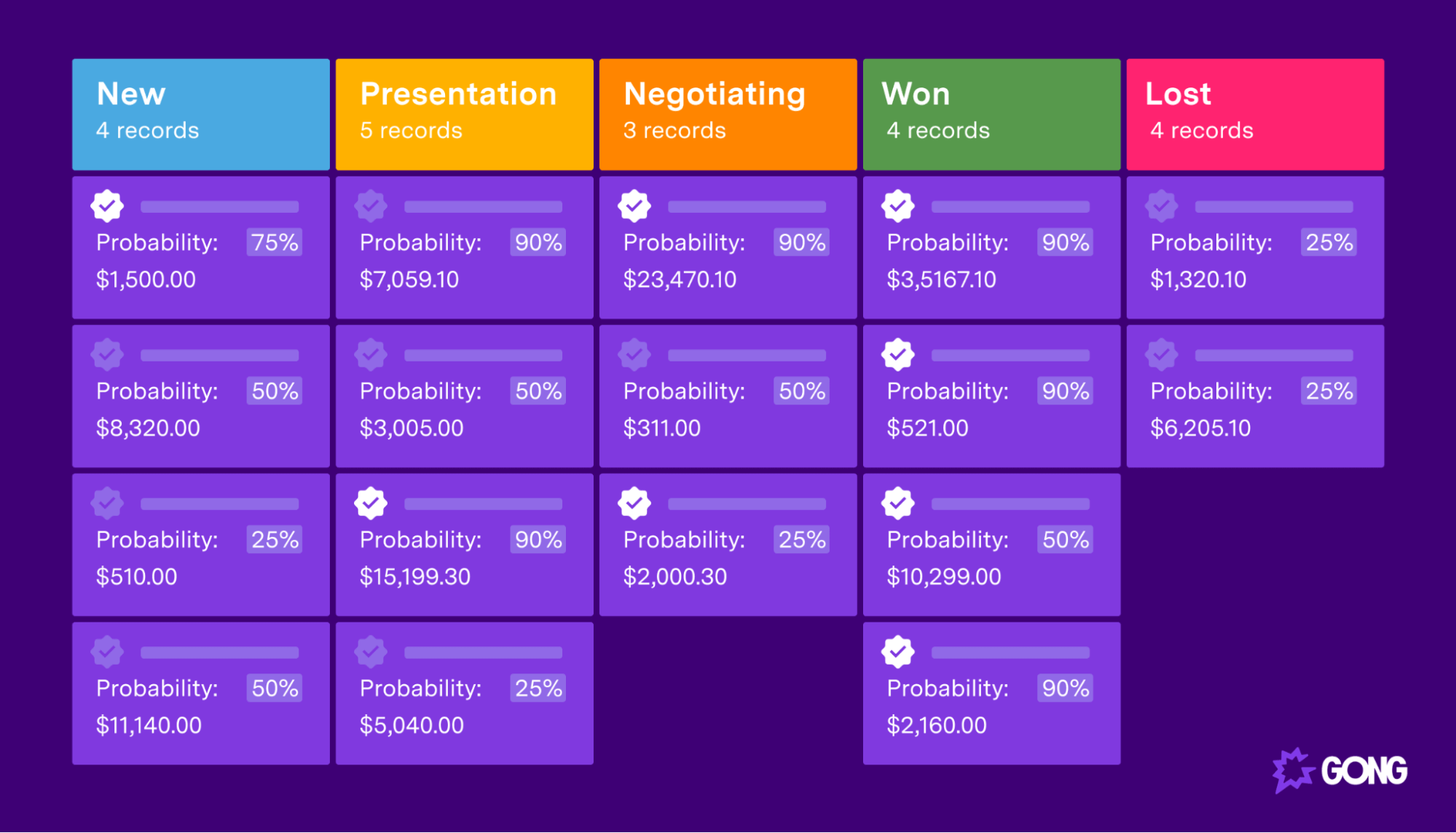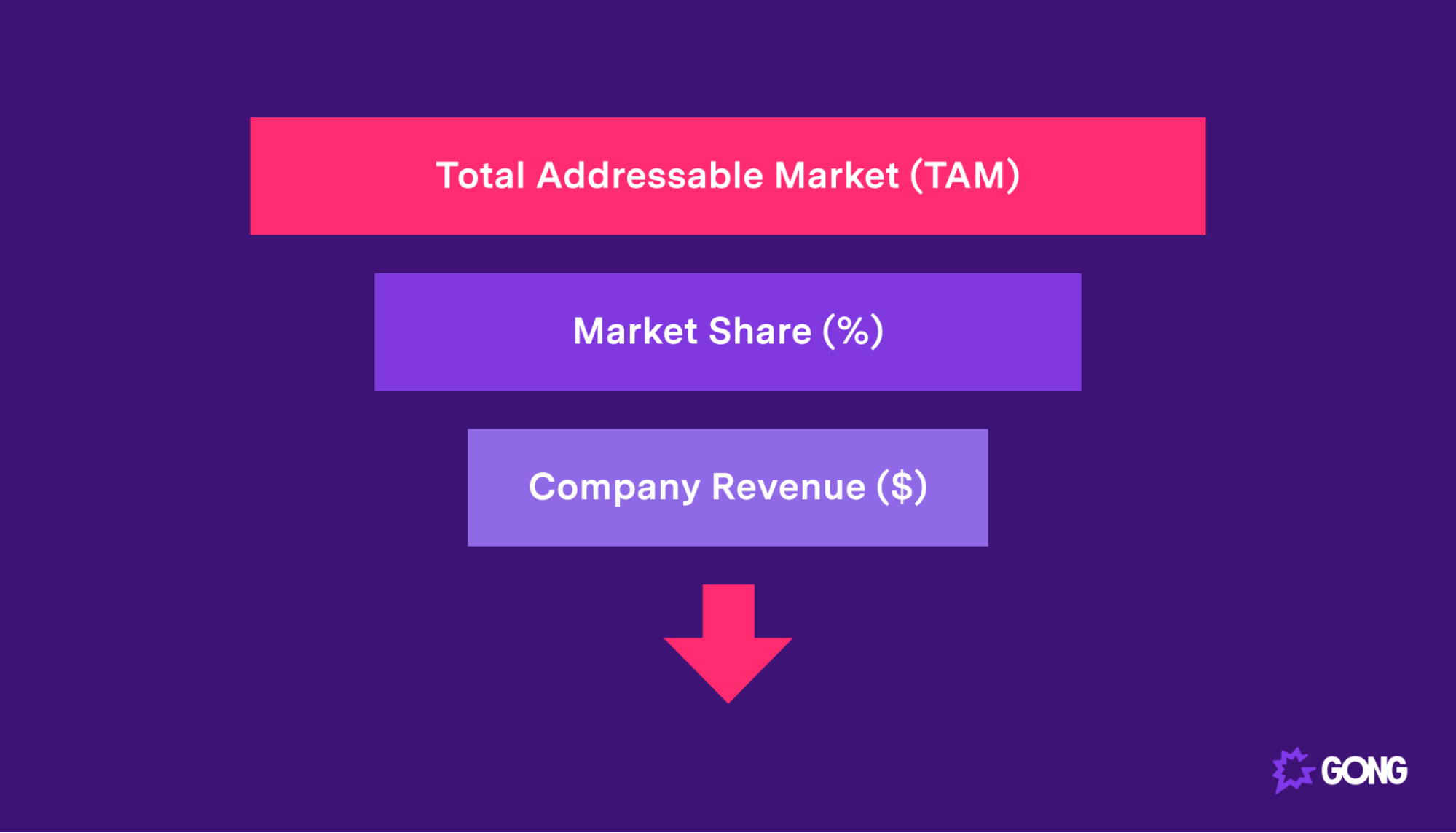6 sales forecast examples that generate more accurate predictions
Sales forecasting is a crucial activity for high-performing sales teams. It helps them create concrete action plans to close more deals in any given quarter.
The problem is there doesn’t seem to be a whole lot of consensus on how to actually do a sales forecast.
Teams of all sizes use a bunch of different methods, making it difficult for those of us looking to put together our first sales forecast to understand what steps to take.
In this article, we’re going to look at six different sales forecast examples using different forecasting methodologies so you can understand and decide which calculation makes the most sense for your organization.
What is sales forecasting?
Before we get into the examples, let’s all get on the same page:
What is sales forecasting anyway?
Sales forecasting is the process of looking forward and projecting what your sales revenue will look like in the coming financial period (usually monthly or quarterly).
While some financial forecasts might look at a year or even two in the future, sales forecasts are much more tangible and shouldn’t look any further than three months ahead.
There are a number of different ways to forecast sales (we’re going to look at six of them shortly), but most of them look at a combination of historical data (previous sales), current information (pipeline reviews and salesperson judgment), and forward-looking estimates (such as new products that are about to hit the market).
Generally speaking, sales leaders are responsible for sales forecasting duties, though they often involve their sales team in this process, particularly if they’re using a pipeline-based methodology.
Sales leaders then forward their sales forecasts up the chain to senior leadership and finance leaders to make important decisions that inform changes to the sales strategy, investments, and resourcing choices.
What’s important when creating a sales forecast?
Sales forecasting should be largely data-driven.
Yes, it’s okay to rely a little on your own intuition and the judgment of your sales reps (they’ll need to tell you how likely it is that a certain deal will close, for instance), but hard data should be your foundation.
So, you’re going to need:
- A clean and up-to-date sales pipeline. Push your reps to keep it updated with deal probabilities loaded in and all lead cards in the correct pipeline stages.
- An understanding of previous performance. Pull your numbers from the past few quarters and analyze growth trends that may be applicable to your forecast.
- Lead scoring/rankings. If your sales team uses a lead scoring or ranking system, this data may prove helpful in formulating a forecast.
- Industry/competitive analysis. It will be important to know of any major changes in your industry. For example, a new market entrant may disrupt sales, as might a legislative change relevant to your vertical.
Gather the above information, then dive into your sales forecast, using the below examples as a reference.
Still need more guidance?
Get our expert tips on how to create your sales forecast.
6 sales forecast examples
Ready to create your own sales forecast but not sure where to start?
Explore six different sales forecast examples below, each using a different methodology for projecting sales revenue.

Note the differences, and choose the sales forecasting methodology that best suits your organization.
1. Historical data forecast
A historical data sales forecast is exactly as it sounds.
You’re going to look at historical sales records (i.e., sales volumes and revenue figures for previous quarters) and use them to estimate future sales.
A smarter historical data forecast would take into account growth trends. Note that in the above example, sales revenue is growing at $20k per quarter. So, we could assume that if our quarter four sales revenue was $290k, quarter one of the following year should be $310k.
Historical forecasting is great because it’s easy, but that’s about it.
As your stockbroker will tell you (if they’re honest): ”past performance is not indicative of future results.”
That’s the major drawback of relying solely on historical data for sales forecasts; you’re not taking into account what’s happening right now (in your pipeline and in the market).
2. Opportunity stage probability forecast
This kind of sales forecast looks at the deals you have in your sales pipeline right now and builds a projection based on:
- The probability of closing at each stage of the sales process
- The expected revenue from each deal
This type of forecast obviously depends on you having that data available, meaning your sales reps need to be proactive with adding deal amounts to each card, and you need to have deal stage probabilities loaded in based on historical performance.

Let’s say you have the following deal stage probabilities:
- Prospecting – 10%
- Qualification – 25%
- Proposal – 40%
- Negotiation – 60%
- Closing – 90%
First, analyze each sales opportunity and add up the expected future revenue from each deal. Let’s say yours looks like this:
- Prospecting – $2.5m
- Qualification – $1.2m
- Proposal – $800k
- Negotiation – $700k
- Closing – $450k
For this sales forecasting model, you’ll simply multiple the revenue projections for each deal stage by the average sale probability at each stage, for example:
- Prospecting – $2.5m x 10% = $250k
- Qualification – $1.2m x 25% = $300k
- Proposal – $800k x 40% = $320k
- Negotiation – $700k x 60% = $420k
- Closing – $450k x 90% = $405k
Your sales forecast, in this case, is the total across all deal stages (in this case, $1.695m).
Deal stage probability is one of the more accurate sales forecasting methods, plus it’s pretty easy to pull together (at least if you use a revenue intelligence platform).
It does have a couple of drawbacks, however.
First neglects to include the age of each deal. A 3-month-old deal sitting in Qualification doesn’t have the same likelihood of closing as a 3-day-old deal, right?
Secondly, the opportunity stage probability forecast assumes that conversion rates remain constant from one period to the next. We know this isn’t always the case, and thus can lead to wide gaps in the accuracy of your forecasts.
Looking at the above example, if we were to lose 10% conversion rate in the Closing stage, the forecast would be around $45k off.
3. Sales cycle forecast
The sales cycle method covers what the previous sales forecasting process missed: the age of each sales opportunity.
Busy sales pipelines often include old deals (even though that’s commonly a sales manager no-no), so the sales cycle forecasting method takes this into account.
With this method, you compare the age of the deal to the average sales cycle length. You’ll need to come up with a weighting system based on deal age.
Let’s say, for example, that the average period of time for a deal to close at your organization is 62 days, and we’re going to weight deals into five categories:
- Over 62 days – 10% close likelihood
- 45-62 days – 30% close likelihood
- 31-44 days – 45% close likelihood
- 18-30 days – 35% close likelihood
- 0-18 days – 25% close likelihood
Then, you’ll multiply each deal’s relevant close likelihood by its expected revenue, add it all up, and there’s your sales forecast.
The sales cycle forecasting method is similar to the deal stage probability forecast in that it has a drawback. It pays attention to the age of each opportunity but ignores historical probability based on the pipeline stage that deal is in.
For more accurate sales forecasts, consider using both approaches and then taking an average figure.
Need a refresher on sales cycles? Here’s our complete guide to understanding the sales cycle.
4. Bottom-up forecast
The pipeline-based sales forecast is probably the most commonly used method for creating sales projections.
It’s one of the best ways to build an accurate forecast because it’s purely based on the deals your team has in play right now.

Of course, you’ll need to rely on what your reps say about the likelihood of each deal closing, but you trust them, right?
With this methodology, sales organizations perform a thorough pipeline review, going through each deal on the table and asking:
- What’s likely to close (and what isn’t?)?
- Why or why not?
- What’s the dollar value of each of these sales deals?
- What time periods are we looking at? (i.e., are they going to close in the upcoming months that we’re currently forecasting for?
Then, you simply add up the total value of each of the deals, and there’s your forecast.
If you want to get a little more sophisticated, you can combine other types of forecasts, using actual sales data from previous periods and historical deal stage probabilities to supplement sales rep intuitions.
Or, you can just jump straight in with your Bottom-Up Sales Forecast Template for Excel.
5. Top-down sales forecast
Top-down sales forecasts don’t look at what you’ve got in the pipeline now. Instead, they assess the total revenue value of the target market (which we call the total addressable market) and your company’s ability to capture that revenue.

Here’s how it works:
First, you need to determine what the TAM dollar value is. Let’s say in your industry, it’s $250m.
Then, you look at your market share. Maybe you own 10% of the market.
From here, it’s just a bit of simple math: $250m x 10% = $25m. What’s your annual sales forecast?
As you’re probably thinking, this isn’t the most accurate forecasting method. It relies on a knowledge of your available market, but that doesn’t mean they’re ready to buy.
Plus, it doesn’t take into account:
- Your sales team’s ability to close deals
- Your marketing team’s developments for the coming period
- Changes to the business plan which may impact monthly sales
The top-down sales forecast is best used by those who are new to the market and who can’t analyze a sales pipeline or review historical sales data.
6. Multi-variable forecast
Multi-variable sales forecasts are a little complicated, but they’re the most accurate around.
More typically used by larger organizations, multi-variable forecasts combine the approaches we’ve looked at above.
For instance, you might start with a pipeline review led by your sales reps, based on their own intuition and understanding of what opportunities are likely to turn into sales.
Then, you’ll check out the historical sales trend. How fast is sales revenue growing? 3% a quarter? How does that align with the pipeline-based forecast?
You may also compare sales rep predictions with deal stage probabilities to assess accuracy (or maybe your probabilities need updating).
On the whole, there is no single way to perform a multi-variable sales forecast. Each organization uses a different formula.
We’d recommend experimenting with each of the above methods and assessing which are the most accurate for your company.
Then, you can build a multi-variable calculation that makes sense.
Dive into sales forecasing with Gong
Sales forecasting can be a painful, long-winded process that takes a large team of reps, managers, and sales leaders days of meetings and dredging through reports.
Notice, though, that we said can.
That’s because if you’re savvy with a bit of tech, you can get your sales forecasting software to take care of the whole thing for you or at least help you get there much faster.
Ready to dive in? Get our free sales forecasting template here and start making more accurate revenue projections.